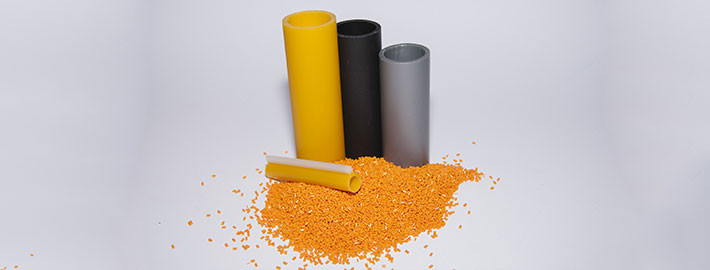AMP verarbeitet eine Vielzahl von extrudierten Kunststoffen: vom gewöhnlichen PVC zu den weniger verbreiteten Bio-Kunststoffen, alles gemäß Ihren Anforderungen und den Eigenschaften Ihres Produktes.
PVC - Polyvinylchlorid
Zum entsprechenden Abschnitt – PVC-Extrusion

PVC belongs to the category of thermoplastic and has an amorphous structure, a high strength and a high modulus of elasticity. PVC is used with a temperature of between -10 ° C and + 60 ° c, has excellent characteristics of stability and chemical resistance to acids.
It is a good electrical insulator and absorbs little water , is physiologically inert , but the use in the food depends on the type of stabilization that has undergone. It has an excellent resistance to fire, it is self-extinguishing and also you can solder paste .
Due to its high resistance to acids, PVC is widely used in the production of components for chemical electroplating and petrochemical industries.
The uses of PVC are numerous : it can be shaped by molding , hot extruded , calendered , or reduced to a liquid for coating of fabrics , surfaces, tanks , valves, taps , baths and artificial textile fibers .
TYPICAL APPLICATIONS :
- pipes for building – gutters, drain pipes and drainage pipes for drinking water , ..
- slats for roller shutters
- conduits for electrical wiring
- profiles for windows and doors
- profiles for various applications
In terms of application, the PVC plastic is the most versatile known. It is the “vinyl ” by definition, used for the production of records.
ABS - Acrylnitril-Butadien-Styrol
Zum entsprechenden Abschnitt – ABS-Extrusion

It ‘a common thermoplastic polymer used to create light and rigid objects, such as pipes, musical instruments (especially the flute and clarinet), golf club heads, parts or whole car bodies and toys like the famous LEGO bricks, as well as that acts as a container for assembly of electrical and electronic components. In the field of hydraulics ABS pipes are black, while those of PVC are white, orange or gray.
The properties of ABS are due to the simultaneous contribution of each of its constituents:
acrylonitrile increases the heat resistance, toughness and chemical industries,
butadiene provides the impact resistance being an elastomer,
styrene provides surface gloss, stiffness and ease of processing
TYPICAL APPLICATIONS:
- drainage pipes, drainage and venting of buildings
- electrical conduits
- profiles for electrical and electronic equipment
PC - Polycarbonat
Zum entsprechenden Abschnitt – PC-Extrusion

Polycarbonates are resistant to mineral acids, aliphatic hydrocarbons, gasoline, greases, oils , alcohols , except methyl alcohol , and water below 70 ° C. Above this temperature the water attacks the polymer favoring a gradual chemical decomposition. The biodegradability is poor and time-consuming .
The mechanical properties , such as elongation , tensile strength, resistance to impact and flexion , show a rapid increase with the molecular weight up to reach a plateau for values of the molecular weight of around 22 000, for which the weight is still guaranteed a good workability for extrusion . Of paramount importance for the application of polycarbonate is its high toughness , high impact resistance , excellent thermal stability and good transparency .
Polycarbonate is one of the last thermoplastic materials to be produced and marketed , but despite this it has been a spectacular growth in consumption in different application fields , from construction to electronics, from electro- lately to the automotive industry.
TYPICAL APPLICATIONS :
- in electronics, such as insulation for high-voltage capacitors and high voltage work
- electric lighting , for transparent
- in the medical field the polycarbonate has found wide use : the possibility to sterilize in autoclave or by gamma rays , some compounds based PC has allowed the use in the equipment for hemodialysis and for the artificial heart surgery, for the first infancy and home care
PUR - Polyurethan
Zum entsprechenden Abschnitt – PUR-Extrusion

Polyurethane’s a material used in technical profiles in contact with oils, metals, and where there is a strong friction processing. Material with much elastic memory, PU has the ability to adapt to any type of profile.
Typical applications areas ranging from automotive, construction, medical until:
- insulating gaskets
- tubes
- technical profiles
PE - Polyäthylen
Zum entsprechenden Abschnitt – PE-Extrusion

Polyethylene is a thermoplastic polymer derived from petroleum; it is present in high density variants (HDPL ) and low density ( LDPL ) .
The HDPL high density has little branching , with the result that the intermolecular forces and tensile strength are higher than in the less dense variety of polyethylene ; it is also harder and more opaque and can withstand temperatures (120 ° C for short periods , 110 ° C continuously ) .
TYPICAL APPLICATIONS:
- piping Interrante and not for the transport of fluids under pressure
- piping systems resistant to aggressive chemicals and / or high temperature ( for example , for the transfer of geothermal heat )
- piping for the distribution of natural gas , water, for domestic services
- insulators interior of coaxial cables
- tubes and profiles that require flexibility , very soft and pliable , such as coatings for cables for telecommunications
- The LDPL low density can withstand temperatures of 80 ° C continuously and 95 ° C for a short period .
It has more ramifications of high density polyethylene , so its intermolecular forces are weaker , the tensile strength is lower and the resilience is greater ; has an excellent resistance to dilute solutions and concentrated acids , alcohols , bases and esters and good resistance to aldehydes , ketones and vegetable oils , and has a limited resistance to aliphatic and aromatic hydrocarbons , mineral oils and oxidizing agents.
Biokunststoff

Bioplastic is a type of biodegradable plastic derived from renewable vegetable raw materials and with a decomposition time of a few months in composting.
The most commonly known and widespread bioplastic on the market (even for its relatively low cost) is derived from starch made from corn, wheat, from the potato, tapioca and rice. Trade names of this biopolymer are now entered in everyday language and include the Mater-Bi ® and Bioplast ® (although there are many other equally used worldwide as Cornpol ®, Greenpol ®, Ecoplast ®, ® and TP Getrex Plantic ®) .
TYPICAL APPLICATIONS
- Protections for agriculture
- Handles, door handles and profiles
- Pipes and containers






